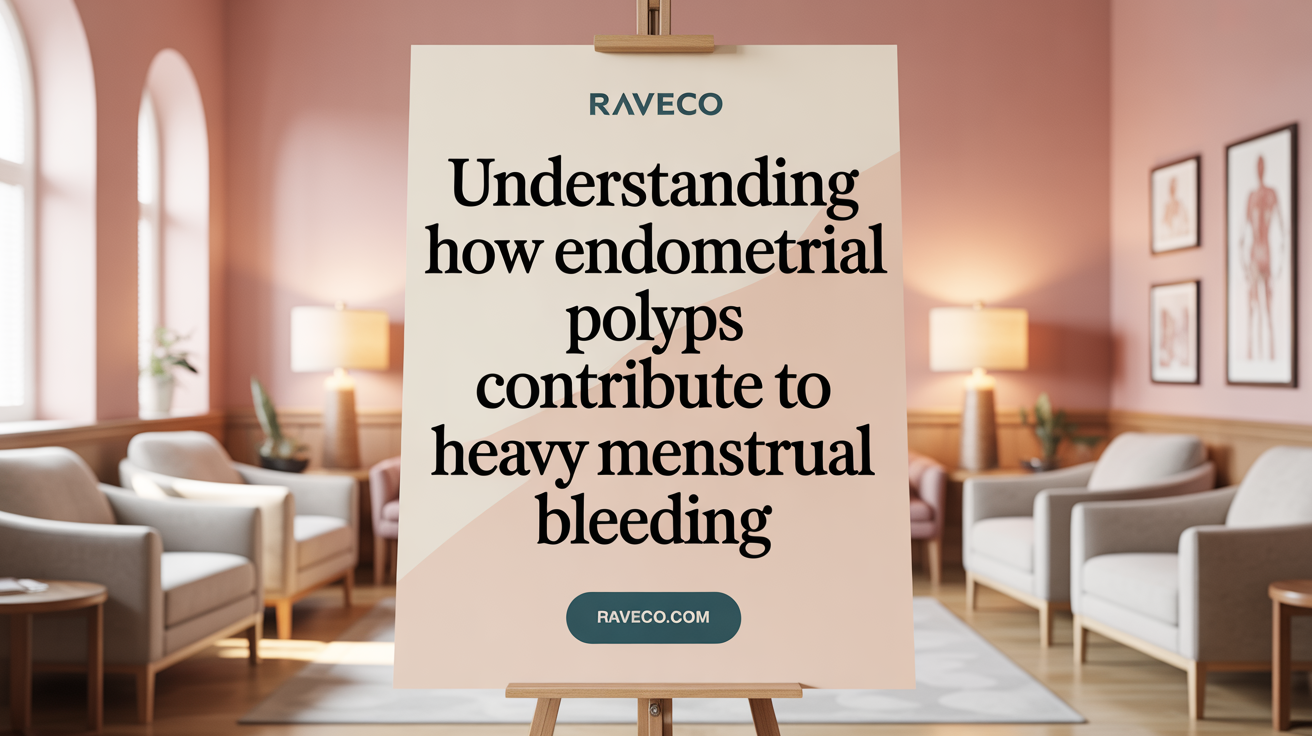Recognizing the Right Time to Address Female Infertility: Key Indicators and Expert Care in Queens

Unveiling the Connection Between Heavy Bleeding and Endometrial Polyps
Heavy menstrual bleeding is a common and distressing symptom experienced by many women, often signaling underlying health issues within the uterus. One significant but sometimes overlooked cause is the presence of endometrial polyps—benign growths arising from the uterine lining that can disrupt normal menstrual flow. This article explores the intricate relationship between these polyps and heavy bleeding, outlining symptoms, risk factors, diagnostic approaches, treatment options, and the broader implications for women's reproductive health.
The Role of Endometrial Polyps in Causing Heavy Menstrual Bleeding

What are endometrial polyps?
Endometrial polyps are small, soft growths that develop on the lining of the uterus, known as the endometrium. They are usually benign, meaning noncancerous, and can vary in size from just a few millimeters to several centimeters. These polyps can be single or multiple and often grow attached to the uterine wall by a thin stalk.
How do polyps contribute to heavy or excessive bleeding?
Endometrial polyps are sensitive to estrogen, a hormone that influences the growth of the uterine lining. When estrogen levels increase, they can cause the polyps to enlarge. As they grow, they may interfere with the normal shedding of the uterine lining, leading to irregular or heavy menstrual bleeding. Polyps located near the cervix or on the uterine fundus are especially prone to causing excessive bleeding because they affect the blood supply and the shedding process.
Symptoms and clinical presentation related to heavy bleeding
Women with endometrial polyps most commonly experience abnormal vaginal bleeding. This can include:
- Heavy menstrual periods that last longer than usual
- Irregular or unpredictable bleeding patterns
- Spotting or bleeding between periods
- Bleeding after menopause, which is abnormal and warrants medical attention
Besides heavy bleeding, some women may notice prolonged periods or bleeding that is heavier than their normal cycle. While many polyps do not cause pain, occasionally larger polyps may lead to a dull aching sensation in the lower abdomen or back.
Prevalence of polyps in women with abnormal uterine bleeding
Endometrial polyps are significantly associated with abnormal uterine bleeding (AUB). Studies show that up to 50% of women experiencing AUB have polyps, making them a common cause of these symptoms. The prevalence increases with age, particularly in women in their 40s and 50s, often around perimenopause or after menopause.
Estrogen sensitivity and hormonal influence
The growth of endometrial polyps is strongly linked to hormonal factors, especially estrogen. Elevated estrogen levels encourage proliferation of endometrial tissue, which can lead to polyp formation. Use of certain medications like tamoxifen, hormone replacement therapy with high estrogen doses, or conditions that increase estrogen, such as obesity, raise the risk of developing polyps. Their estrogen sensitivity explains why polyps tend to grow during reproductive years and may enlarge or cause symptoms when hormone levels fluctuate.
Most importantly, the presence of these polyps can disrupt the normal menstrual cycle and lead to significant blood loss. Because of their hormonal responsiveness, managing estrogen levels can sometimes help control polyp growth, but removal remains a common and effective treatment to resolve symptoms and assess for the potential risk of malignancy.
Causes and Risk Factors Behind the Development of Endometrial Polyps
 Endometrial polyps are growths that develop when there is an overgrowth of cells lining the uterus, known as the endometrium. While the precise cause of these polyps remains unclear, current understanding indicates that hormonal influences, especially estrogen, play a significant role.
Endometrial polyps are growths that develop when there is an overgrowth of cells lining the uterus, known as the endometrium. While the precise cause of these polyps remains unclear, current understanding indicates that hormonal influences, especially estrogen, play a significant role.
Estrogen, a hormone that promotes the thickening of the endometrial lining, can stimulate abnormal growth when its levels are elevated or unopposed by progesterone. This hormonal stimulation is often linked to various risk factors. For example, women taking medications such as tamoxifen, which acts as an estrogen receptor agonist in the uterine tissue, have an increased likelihood of developing polyps. Similarly, hormone replacement therapy (HRT) with high doses of estrogen also elevates risk.
Obesity is a critical factor, as excess fat tissue increases estrogen production through aromatization, the process of converting androgens into estrogen. As women age, particularly in their 40s and 50s, natural hormonal fluctuations and decreased progesterone levels can contribute to abnormal endometrial growth. Postmenopausal women, who normally experience low estrogen levels, may develop polyps if estrogen levels are high due to exogenous sources.
Genetic factors also influence polyp development. Conditions like Lynch syndrome and Cowden syndrome, which are inherited disorders associated with increased cancer risk, can predispose women to uterine polyps. Additionally, chronic inflammation and chromosomal abnormalities are thought to contribute to abnormal tissue proliferation.
The combined effect of these factors fosters an environment where the endometrial tissue proliferates excessively, leading to the formation of polyps. Larger or multiple polyps are more common with advancing age and may carry a higher risk of becoming cancerous, especially in postmenopausal women.
Understanding these hormonal and genetic influences helps in assessing individual risk and guiding management to prevent potential progression to malignancy.
Diagnostic Approaches for Identifying Endometrial Polyps in Heavy Bleeding Cases
 When women experience heavy menstrual bleeding, one common underlying cause can be endometrial polyps. Accurate diagnosis is essential for appropriate management and to rule out potential malignancies.
When women experience heavy menstrual bleeding, one common underlying cause can be endometrial polyps. Accurate diagnosis is essential for appropriate management and to rule out potential malignancies.
The initial imaging technique often used is transvaginal ultrasound (TVUS). This method allows clinicians to visualize the uterine cavity and identify echogenic, localized endometrial masses suggestive of polyps. The accuracy of TVUS varies with sensitivity ranging from 19% to 96% and specificity from 53% to 100%. While helpful, it may sometimes miss small polyps or confuse other uterine abnormalities.
To improve diagnostic accuracy, saline infusion sonohysterography, also known as sonohysterography, is frequently employed. This minimally invasive procedure involves filling the uterine cavity with saline to create a clear contrast. The saline enhances the visualization of polyps, which appear as fluid-filled masses projecting into the cavity. Sonohysterography is considered the gold standard for diagnosing endometrial polyps because of its high sensitivity and specificity, providing detailed images that assist in both diagnosis and subsequent treatment planning.
Hysteroscopy plays a dual role—diagnostic and therapeutic. During hysteroscopy, a small camera is inserted into the uterus, giving direct, real-time visualization of the endometrial surface. This enables precise identification of polyps, especially those that are not easily seen on ultrasound. Hysteroscopy also allows for immediate removal of polyps through guided excision, making it both a diagnostic and a treatment tool.
Histological confirmation remains the definitive diagnosis. Endometrial tissue or suspected polyps are usually sampled during hysteroscopy or curettage procedures. This tissue undergoes microscopic examination to confirm benignity or detect premalignant changes or cancer. Regular biopsy is preferred over blind curettage because it ensures targeted sampling from suspicious areas.
Given the variety of diagnostic tools, a combined approach is often best—initial evaluation with ultrasound, confirmation with saline infusion sonohysterography, direct inspection via hysteroscopy, and tissue sampling for histopathology. These methods collectively enable accurate diagnosis of endometrial polyps, differentiate them from other uterine conditions like fibroids or hyperplasia, and guide appropriate management especially in cases of heavy bleeding.
| Diagnostic Method | Description | Diagnostic Accuracy | Additional Notes |
|---|---|---|---|
| Transvaginal Ultrasound | Visualizes endometrial region | Sensitivity 19–96%; Specificity 53–100% | First-line screening tool |
| Saline Infusion Sonohysterography | Enhances ultrasound with saline | Gold standard; High sensitivity and specificity | Provides detailed cavity images |
| Hysteroscopy | Direct visualization of uterine cavity | Sensitivity ~94%; Specificity ~92% | Allows immediate biopsy and removal |
| Endometrial Biopsy | Tissue sampling for histology | Confirmatory | Can miss small polyps; better with hysteroscopy |
Overall, combining imaging with tissue diagnosis offers an effective strategy for identifying endometrial polyps in women with heavy bleeding, effectively distinguishing benign lesions from those requiring further intervention.
Treatment Strategies and Outcomes for Endometrial Polyps Causing Heavy Bleeding
 Hysteroscopic polypectomy is widely regarded as the definitive treatment for endometrial polyps that cause heavy menstrual bleeding. This minimally invasive procedure involves the hysteroscopic removal of polyps, providing both symptom relief and tissue samples for histopathological examination to rule out malignancy. Its high success rate in alleviating bleeding symptoms makes it the standard approach.
Hysteroscopic polypectomy is widely regarded as the definitive treatment for endometrial polyps that cause heavy menstrual bleeding. This minimally invasive procedure involves the hysteroscopic removal of polyps, providing both symptom relief and tissue samples for histopathological examination to rule out malignancy. Its high success rate in alleviating bleeding symptoms makes it the standard approach.
In addition to surgical removal, hormonal therapies play a supportive role. Medications like progestins, the levonorgestrel intrauterine system (LNG-IUS), or gonadotropin-releasing hormone (GnRH) agonists may be used to manage symptoms or reduce polyp size. These options might be suitable for women who are not ideal candidates for surgery or as an adjunct to improve outcomes.
For small or asymptomatic polyps, watchful waiting can be a reasonable strategy. Some polyps tend to regress spontaneously without intervention, especially when they are not causing significant symptoms or have low suspicion for malignancy.
Removing polyps has proven effective in reducing heavy menstrual bleeding, with many women experiencing marked improvements in their bleeding patterns post-procedure. This is primarily because polyps are often the underlying cause of abnormal, excessive bleeding. However, other conditions like fibroids or hormonal imbalances may also contribute, and should be considered during diagnosis to ensure comprehensive treatment.
Risks associated with polypectomy are generally low, with recurrence being uncommon but still possible, particularly in women with risk factors like obesity. Early detection through procedures like hysteroscopy not only helps treat bleeding but also aids in preventing the progression of potential pre-cancerous changes, emphasizing the importance of regular gynecological checkups for women with previous polyps or abnormal bleeding.
Medical and Reproductive Health Implications of Endometrial Polyps with Heavy Bleeding
What medical implications does heavy bleeding caused by endometrial polyps have?
Heavy bleeding from endometrial polyps can lead to anemia, which may cause symptoms like fatigue, weakness, and dizziness. Persistent or excessive bleeding also impacts quality of life, leading to physical discomfort and emotional stress. Since irregular bleeding can sometimes be a sign of precancerous or cancerous changes, thorough evaluation is necessary when heavy bleeding occurs. Moreover, ongoing blood loss can result in iron deficiency anemia if untreated. In such cases, medical treatments might include medication or surgical removal of the polyps, such as hysteroscopic polypectomy, to control symptoms and prevent complications.
When should an endometrial polyp be a cause for concern?
Endometrial polyps warrant concern when they are linked to abnormal or persistent bleeding, especially in women after menopause. This is because such symptoms might indicate a higher risk of malignancy. Older women and those with atypical hyperplasia within the polyp also face increased cancer risk. Additional warning signs include rapid polyp growth, large size, multiple polyps, or risk factors like obesity, unopposed estrogen therapy, or a family history of endometrial cancer. These factors suggest the need for diagnostic procedures such as ultrasound and biopsy to assess for potential cancerous changes.
Can endometrial polyps affect fertility and overall reproductive health?
Yes, endometrial polyps can interfere with fertility by disrupting embryo implantation, affecting sperm movement, or altering the uterine environment. Women with infertility and abnormal uterine bleeding frequently have polyps, and their removal improves reproductive outcomes. Hysteroscopic excision of polyps enhances the chances of conception, whether naturally or through assisted reproductive technologies. Addressing polyps not only alleviates bleeding symptoms but also boosts the likelihood of pregnancy, thus playing a vital role in reproductive health management.
Managing Endometrial Polyps to Alleviate Heavy Bleeding and Protect Women's Health
Endometrial polyps represent a significant yet manageable cause of heavy menstrual bleeding that can profoundly affect a woman's quality of life and reproductive potential. Understanding their symptoms, hormonal underpinnings, and risk factors enables timely diagnosis and effective intervention. Advanced imaging and hysteroscopic techniques facilitate accurate detection and minimally invasive removal, which not only alleviates bleeding but also identifies any malignant changes requiring further care. Given their potential to disrupt fertility and cause anemia, ongoing monitoring and individualized treatment plans are essential. Women experiencing heavy or irregular bleeding should seek medical evaluation to rule out polyps and ensure comprehensive management for optimal health outcomes.
References
- Uterine Polyps: Causes, Symptoms, Diagnosis & Treatment
- Uterine polyps - Symptoms & causes - Mayo Clinic
- Heavy Periods | Polyps | Fibroids - Women's Care
- Prevalence of endometrial polyps and abnormal uterine bleeding in ...
- Uterine Polyps May Cause Excessive Bleeding, What Are They?
- The Importance of Endometrial Polyp Removal - Audubon Fertility
- Endometrial Polyps - Baylor College of Medicine
- What causes heavy periods? | The Royal Women's Hospital
- Endometrial Polyps and Abnormal Uterine Bleeding (AUB-P)





.png)